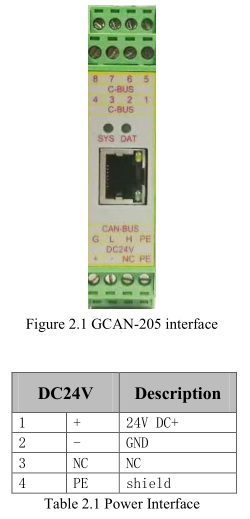Introduce The Product Of Modbus/TCP to CAN converter_GCAN
1. Introduction
1.1 Overview
The GCAN-205 is a CAN-Bus and ethernet converter. GCAN-205 converter ethernet-side integrated Modbus TCP protocol. GCAN-205 can convert the data between CAN-Bus and Modbus TCP. With this converter, equipment that used Modbus TCP protocol can connect to CAN-Bus without changing the hardware structure, this makes multi-Bus interconnection very flexible, and extends the application scope of CAN-Bus.
1.2 Properties at a glance
1.2.1 Hardware
High-speed 32-bit processor
Embedded hardware watchdog timer
Power supply voltage: DC 24V, maximum current: 40mA
Electrostatic discharge immunity level: contact discharge ± 2KV, air discharge ±15KV
Electrical fast transient burst immunity level: ± 1KV
Surge immunity level: ± 1KV
Operating temperature range: -40 ℃ ~ +85 ℃
Operating humidity range: 5% to 95% RH no condensation
Dimensions:113mm * 100mm * 21mm
Standard DIN rail mounting, designed for industrial design
1.2.2 CAN
Integrated 1 CAN-Bus interface with terminal
CAN-Bus signals include: CAN_H, CAN_L, CAN_GND
CAN-Bus supports CAN2.0A and CAN2.0B frame format, conform to ISO/DIS 11898 standards
CAN-Bus baud rates range from 5Kbps to 1Mbps
CAN-Bus isolation converter insulation voltage: DC 1500V
1.2.3 Ethernet
RJ45, support 10 / 100M adaptive
Modbus slave support function code: 03H, 04H, 06H, 16H
Support static or dynamic IP access
Support heartbeat and timeout interrupt function
The working port is fixed, the target IP and the target port can be set
After the network is disconnected, the connection resource is automatically restored and the TCP connection is established reliably
Support protocols include EtherNET, ARP, IP, ICMP, UDP, DHCP, DNS, TCP
Compatible with SOCKET work (TCP Server, TCP Client, UDP, etc.), the host computer communication software follows the standard SOCKET rules
2. Installation
The GCAN-205 interface information is shown in Figure 2.1. The power interface is defined in Table 2.1.

1.1 Overview
The GCAN-205 is a CAN-Bus and ethernet converter. GCAN-205 converter ethernet-side integrated Modbus TCP protocol. GCAN-205 can convert the data between CAN-Bus and Modbus TCP. With this converter, equipment that used Modbus TCP protocol can connect to CAN-Bus without changing the hardware structure, this makes multi-Bus interconnection very flexible, and extends the application scope of CAN-Bus.
1.2 Properties at a glance
1.2.1 Hardware
High-speed 32-bit processor
Embedded hardware watchdog timer
Power supply voltage: DC 24V, maximum current: 40mA
Electrostatic discharge immunity level: contact discharge ± 2KV, air discharge ±15KV
Electrical fast transient burst immunity level: ± 1KV
Surge immunity level: ± 1KV
Operating temperature range: -40 ℃ ~ +85 ℃
Operating humidity range: 5% to 95% RH no condensation
Dimensions:113mm * 100mm * 21mm
Standard DIN rail mounting, designed for industrial design
1.2.2 CAN
Integrated 1 CAN-Bus interface with terminal
CAN-Bus signals include: CAN_H, CAN_L, CAN_GND
CAN-Bus supports CAN2.0A and CAN2.0B frame format, conform to ISO/DIS 11898 standards
CAN-Bus baud rates range from 5Kbps to 1Mbps
CAN-Bus isolation converter insulation voltage: DC 1500V
1.2.3 Ethernet
RJ45, support 10 / 100M adaptive
Modbus slave support function code: 03H, 04H, 06H, 16H
Support static or dynamic IP access
Support heartbeat and timeout interrupt function
The working port is fixed, the target IP and the target port can be set
After the network is disconnected, the connection resource is automatically restored and the TCP connection is established reliably
Support protocols include EtherNET, ARP, IP, ICMP, UDP, DHCP, DNS, TCP
Compatible with SOCKET work (TCP Server, TCP Client, UDP, etc.), the host computer communication software follows the standard SOCKET rules
2. Installation
The GCAN-205 interface information is shown in Figure 2.1. The power interface is defined in Table 2.1.



